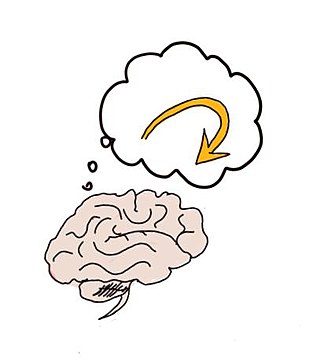History and methods
Early history
The idea of cognitive inertia has its roots in philosophical epistemology. Early allusions to a reduction of cognitive inertia can be found in the Socratic dialogues written by Plato. Socrates builds his argument by using the detractor's beliefs as the premise of his argument's conclusions. In doing so, Socrates reveals the detractor's fallacy of thought, inducing the detractor to change their mind or face the reality that their thought processes are contradictory. [1] [2] Ways to combat persistence of cognitive style are also seen in Aristotle's syllogistic method which employs logical consistency of the premises to convince an individual of the conclusion's validity. [3]
At the beginning of the twentieth century, two of the earliest experimental psychologists, Müller and Pilzecker, defined perseveration of thought to be "the tendency of ideas, after once having entered consciousness, to rise freely again in consciousness". Müller described perseveration by illustrating his own inability to inhibit old cognitive strategies with a syllable-switching task, while his wife easily switched from one strategy to the next. One of the earliest personality researchers, W. Lankes, more broadly defined perseveration as "being confined to the cognitive side" and possibly "counteracted by strong will". [4] These early ideas of perseveration were the precursor to how the term cognitive inertia would be used to study certain symptoms in patients with neurodegenerative disorders, rumination and depression. [5] [6]
Cognitive psychology
Originally proposed by William J. McGuire in 1960, the theory of cognitive inertia was built upon emergent theories in social psychology and cognitive psychology that centered around cognitive consistency, including Fritz Heider's balance theory and Leon Festinger's cognitive dissonance. [7] [8] [9] McGuire used the term cognitive inertia to account for an initial resistance to change how an idea was processed after new information, that conflicted with the idea, had been acquired. [7]
In McGuire's initial study involving cognitive inertia, participants gave their opinions of how probable they believed various topics to be. A week later, they returned to read messages related to the topics they had given their opinions on. The messages were presented as factual and were targeted to change the participants' belief in how probable the topics were. Immediately after reading the messages, and one week later, the participants were again assessed on how probable they believed the topics to be. Discomforted by the inconsistency of the related information from the messages and their initial ratings on the topics, McGuire believed the participants would be motivated to shift their probability ratings to be more consistent with the factual messages. [8] [10] However, the participants' opinions did not immediately shift toward the information presented in the messages. Instead, a shift towards consistency of thought on the information from the messages and topics grew stronger as time passed, often referred to as "seepage" of information. [11] The lack of change was reasoned to be due to persistence in the individual's existing thought processes which inhibited their ability to re-evaluate their initial opinion properly, or as McGuire called it, cognitive inertia. [7]
Probabilistic model
Although cognitive inertia was related to many of the consistency theories at the time of its conception, McGuire used a unique method of probability theory and logic to support his hypotheses on change and persistence in cognition. [12] [13] Utilizing a syllogistic framework, McGuire proposed that if three issues (a, b and c) were so interrelated that an individual's opinion were in complete support of issues a and b then it would follow their opinion on issue c would be supported as a logical conclusion. [7] [3] Furthermore, McGuire proposed if an individual's belief in the probability (p) of the supporting issues (a or b) was changed, then not only would the issue (c) explicitly stated change, but a related implicit issue (d) could be changed as well. More formally:
the required change () on c necessary for maintaining logical consistency among the opinions is
p(c) = p(a & b)
which, assuming that a and b are independent events i.e., that p(a & b) = p(a) p(b) becomes
p(c) = p(a) p(b) + p(b) p(a) + p(a) p(b)
where p(a) and p(b) refer to the initial opinions, before the communication induced changes.
This formula was used by McGuire to show that the effect of a persuasive message on a related, but unmentioned, topic (d) took time to sink in. The assumption was that topic d was predicated on issues a and b, similar to issue c, so if the individual agreed with issue c then so too should they agree with issue d. However, in McGuire's initial study immediate measurement on issue d, after agreement on issues a, b and c, had only shifted half the amount that would be expected to be logically consistent. Follow-up a week later showed that shift in opinion on issue d had shifted enough to be logically consistent with issues a, b, and c, which not only supported the theory of cognitive consistency, but also the initial hurdle of cognitive inertia. [7]
The model was based on probability to account for the idea that individuals do not necessarily assume every issue is 100% likely to happen, but instead there is a likelihood of an issue occurring and the individual's opinion on that likelihood will rest on the likelihood of other interrelated issues. [12]





